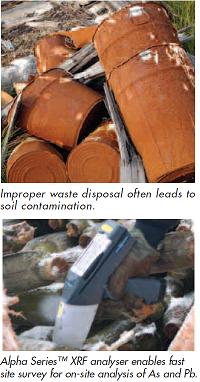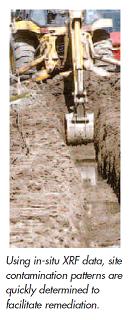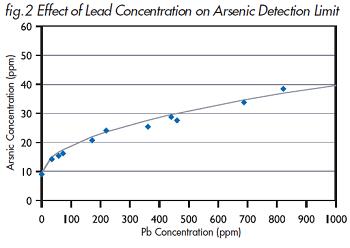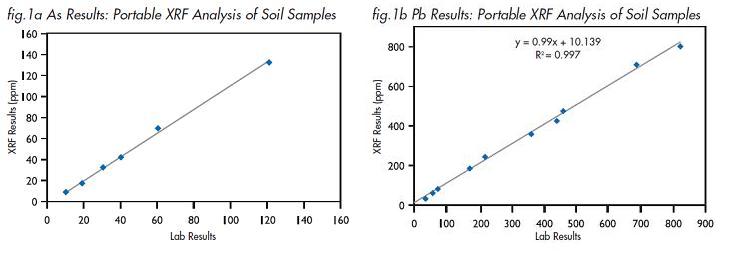 Overview
Overview
For decades, field portable X-ray fluorescence (XRF) has provided rapid, on-site measurements of metals contamination in soil. The purpose of such assessments was the identification and remediation of contaminated soil.
In 1998, EPA incorporated Method 6200 for portable XRF into SWA846 as a standard method. However, because field portable XRF systems used radioactive isotopes as their source of X-rays, they were expensive to own and operate. They also created regulatory burdens for their owners and made site-to-site travel difficult due to the requirements for transporting a radioactive source.
Olympus Innov-X pioneered a handheld XRF analyzer that utilizes an X-ray tube instead of radioactive isotopes. This battery powered point-and-shoot XRF system eliminates burdensome radioactive sources and provides on-the-spot quality data about elements critical to the analysis of metals in soil.
The single X-ray tube replaces multiple isotopes used in source-based systems to offer simultaneous analysis of 20-25 metals including all eight RCRA metals and the EPA priority pollutant metals. It generally provides superior detection limits (DL) compared to isotope systems. Moreover, the testing time never increases with an X-ray tube because there is no source decaying. The testing speed after 4-5 years is the same as when the analyzer was purchased.
Olympus Innov-X developed this technology to overcome the significant regulatory headaches of isotope-based XRF systems. Isotope-based units require the use of radioactive materials to irradiate the sample. The sources decay and lose testing speed over time. In addition to the loss in analytical capabilities, the sources have to be replaced. The use and subsequent disposal of radioactive isotopes also require licensing (state-to-state in the US) and a radioactive materials control program.
Interstate travel is particularly difficult because multiple state licensing and reciprocity arrangements must be made prior to travel - making rapid response impractical. Isotopes can be difficult to ship and transport, as they require hazardous materials declarations and/or permits.
All of these factors add significant additional cost and paperwork for source-based systems - more so for the environmental consulting community where regular travel to multiple job sites is common.
Arsenic and Lead Analysis
Two of the most common metals requiring field analysis are lead (Pb) and arsenic (As). Interestingly, while both of these elements are ideal candidates for XRF analysis, analyzing As in the presence of high Pb concentration presents some challenges, whereas high As content has no effect on the analysis of Pb. Interference-free detection limits (DLs) are shown in Table 1.
| Table 1 Interference-free detection limits (DLs) | |
| Element |
Detection Limit, ppm
(Interference-Free, 2-minute Test Time) |
| Pb | 13 |
| As | 9 |
| *As values represent latest (Aug. 2003) values. | |
Results on laboratory analyzed samples are shown in Fig. 1a and 1b for arsenic and lead respectively. Correlations are good in a variety of soil samples, exhibiting R2 values of 0.99 in each case. The XRF calibration method - Compton Normalization method as described in EPA Method 6200 - provides good results without the need for site-specific calibration corrections.
 | XRF Analysis for Arsenic in the Presence of Lead.While analyzing lead and arsenic with portable XRF is relatively straightforward, analyzing arsenic when lead is present, particularly in high concentrations, poses an additional challenge. Lead produces two strong spectral peaks La at energy 10.5 keV and Lb at 12.6 keV. Generally the lead Lb peak is used for lead analysis. The best arsenic spectral line for measurement is the Ka peak - also at 10.5 keV. Thus lead produces an interference, whereby the lead La completely overlaps the desired arsenic Ka spectral peak. The lead interference becomes detrimental to arsenic measurement in two ways:
The Olympus Innov-X software algorithm automatically corrects the arsenic result when lead is present. The algorithm predicts the contribution in the 10.5 keV spectral reason from the lead La based on the interference-free measurement of the lead Lb. The lead La contribution is subtracted, yielding the peak intensity due solely to the arsenic Ka. |
However, the precision of the arsenic result (and the detection limit in the case of low arsenic concentrations) are affected because the statistical uncertainty of the lead La background subtraction yields a less precise result for the arsenic concentration. This effect does not occur if there is negligible lead present in the spectrum.
The impact on both As detection limit and precision can be determined. The arsenic detection limit as a function of lead concentration is presented in Fig. 2. Based on X-ray measurement statistics, the As detection limit increases as the square root of the increase in lead concentration, following the functional form in the equation below:
Figure 2 shows both the calculated (solid line) and measured arsenic detection limit as a function of lead concentration. For example, for no detectable lead in the sample (< 13 ppm) the As detection limit is approximately 9 ppm. The As DL increases smoothly to a value of about 19 for 100 ppm lead, and about 45 for 1,000 ppm lead. Thus for a 10-fold increase in lead concentration (100 ppm to 1,000 ppm), the detection limit worsens by a factor of about 2.5. The effect on precision of the arsenic measurement will follow a similar trend. |  |
Summary
Olympus Innov-X handheld XRF X-ray tube technology offers faster, higher-precision measurements of important environmental metals in soil and relieves the regulatory burden of using radioactive isotopes. Two of the most common elements analyzed are lead and arsenic. By themselves, both elements are excellent candidates for portable XRF analysis due to the high accuracy achievable, and the low detection limits.
Measurement of low concentrations of arsenic in the presence of high lead concentrations presents some unique challenges due to the large interference of the lead with the arsenic measurement. By quantifying the effect of lead concentrations on arsenic measurements, Olympus Innov-X handheld XRF analyzers provide operators with a way to determine data quality objectives at sites with both Pb and As present, rather than relying solely on interference-free detection limits.




